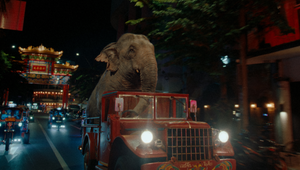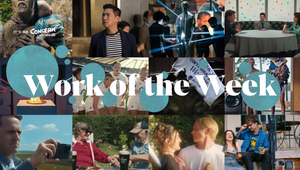
Why Humour Matters

Photo by Tim Mossholder on Unsplash
Here at LBB, we’ve spoken to Ben Leeves numerous times in relation to sound. And even when we aren't speaking to him directly, his name is quite frequently dropped. See, Ben is pretty good at what he does. That’s probably why, when the powers that be were sourcing the team for the latest Tango campaign, Ben ended up coming on board. Everything other than dialogue in the spot is thanks to him.
So. Tango. The brand has become iconic around the western world, largely because of its controversial campaigns that have divided crowds and households alike. Many of you will remember the 1992 ‘Orange Man’ ad that coined the ‘You’ve Been Tango’d’ catchphrase; whilst simultaneously igniting thousands of playground ‘Tango’ assaults. Across the years, despite how infrequent, we could rely on a little taste of Tango-flavoured comic relief in the form of adverts that weren’t there to make any deep or meaningful statements. Instead, they were pieces of creative, intended to be silly for silliness’ sake. Nothing more, nothing less. And there's something truly important about that.
In typical Tango-style, they went quiet for a while; and much of the advertising world seemed to do so in tandem. That's not to say brands stopped making adverts. Of course not. But somewhere along the way, many stopped being silly. That, coupled with an earth-altering pandemic, meant for a long time we’ve been producing and consuming content that is serious at its core. This isn’t necessarily a problem in and of itself - advertising after all, is often a reflection of the world at the time. But we miss humour when it goes away.
We’ve been experiencing a revival of sorts over the past couple of years, with incredible results. The latest episode of the, ‘Apple at Work’ series landed a couple of weeks ago and garnered over 7 million views within three days. The McDonald’s ‘Raise Your Arches’ campaign received over 5 million views on TikTok and had Instagrammers everywhere asking their followers, “Fancy a McDonalds?” When it’s done well, it works well. In this article with Ben, we delve into the campaign itself and more importantly, discuss why humour in advertising matters.
Tango Bust - Squeaky Business
Back when Ben was a junior engineer he remembers working on the first ever Tango ad, doing one of the voice recordings. So the whole thing feels full-circle in a way.
When he initially saw the offline for the new spot, there were some rough ideas that had been contributed for sound - a mood board of sorts. At the initial stage of track laying, he recalls thinking that whilst of course it had to be funny, it had to feel like it was coming from the scene itself: “This was really difficult. One of the hardest things to do is to up or amplify a scene for comedy, whilst making it feel like it's actually happening.” He uses the example of a door creaking open, saying that artificial creaks can be spotted a mile off.
Ben tells us that creating sounds that facilitate comedy differs from creating sounds for other scenes: “You need to remember that humour is already there.” He elaborates that comedy often involves using off-screen sounds to create funny moments, like someone running off-screen and crashing into something, with the sound effect conveying the humour. However, when it comes to comedy scenes that are on-screen, like a person dancing, the challenge lies in finding sounds that can elevate the humour and make it funnier for the viewer.
Sound designers will then experiment endlessly trying to see what works best in a way that feels integrated rather than just being added on top. “It’s all about enhancing in a way that doesn’t feel out of place,” says Ben. “You need to play around with the sound bed to see what’s funny; assess whether or not it has gone too far.”
He tells us that his own process involves a lot of self-editing, “if I think something isn’t working, I’ll bin it before it even gets to the stage where someone listens. You’ll try two seconds of something, ask yourself, ‘does that work?’ If it doesn’t, then ‘bang’ it’s gone.” The next step is going in and synchronising it and embedding it into the scene, “then and only then, you have to be honest with yourself and ask again, ‘does that work?’ And if it doesn’t, it has to go.”

Foley-ing Around
Ben worked meticulously to capture the sound of footsteps and the likes. The scene where the police burst into the room had to sound as if 50 of them were coming into different parts of the building. The music was created from a library of stems ensuring that each element was suited to fit precise moments. Ben used foley to achieve most of the effects in the spot. For those of us who exist outside of the world of sound design, that word might seem alien. Foley is the recreation of everyday sound effects which are added to the film; often, this comes in ridiculous forms.
I asked him how he managed to achieve the squeaking effect that occurs when one of the officers tests the liquid and ends up unable to stop dancing. Ben leaps up from his seat to demonstrate. “I went into the booth with a rubber glove, held it to my belt and danced like he’s dancing in the picture” - he’s saying this whilst dancing and I’m struggling to hear through my own laughter. He continues, “I did take after take of that. I then tried it with a leather belt and a wallet, all whilst using my hands to stretch the glove whilst dancing - it’s all in the hips!”
When he attempted to achieve the sound without the dancing, it just didn’t fit the bill. It turned out to be the longest time Ben had ever spent on foley for one sequence. Other foley included running, lots of breathing, jumping and moving things from place to place. One particular challenge however, that became quite painstaking and involved a hefty amount of trial and error, was achieving the sound of the drip entering the can.
Try that one at home and measure the frequency of your success rate.
Why It Matters
We asked Ben, "Do you think this spot highlights the overarching importance of being silly sometimes?"
He responded, "Oh immensely. I mean, if anything we need more of it. To do an out and out funny ad is actually quite rare. There should be more humour in advertising. People find different things funny and that’s the good thing. You might not make everybody laugh but it might make some. Maybe it’s about bravery."
Humour in advertising as we know it can be a tightrope act - tickling the funny bones of some whilst falling flat for others. Yet this diversity is exactly what gives humour its charm, as it can resonate uniquely with each viewer, potentially forming a bond with the brand. Ben expounds the delicate balance that is demanded here - he insists however, that it is worth the risk. Whilst a humorous gem might fizzle if met with the blank stares in a focus group, embracing such uncertainty and forging ahead might make for something remarkable.
Post Cannes 2023, System1’s, ‘Test Your Ad’ platform assessed the public response to those awarded at the festival. The main finding was that humour had made a comeback as an award-winning element in advertising. Over half of the Film Lions winners were intentionally funny at 52%. By contrast, brand purpose, which for the past 5-10 years has been prominent, appears to have taken a backseat. But that wasn’t all. The research showed that humour in advertising must listen closely to the needs of its viewership in order to gain the success it might desire. Again, it’s about balance.
A little dose of humour, if done right, offers some much-needed comic relief from the seriousness of everyday life; a little respite from the daily challenges and continuing global crises. When cleverly crafted, humour in ads not only works to uplift, but can be a welcome reminder of the power of joy and connection.
In a world hungry for smiles, humour may not only captivate individuals, but fortify brands with a charm that lingers long after the laughter fades.















